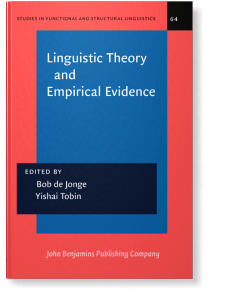Linguistic Theory and Empirical Evidence
Editors
This volume further elaborates the empirical tradition of Columbia School (CS) Linguistics by offering diverse empirical analyses for a wide variety of languages. These studies open a much needed debate advocating the necessity of the independent validation of linguistic hypotheses. This research exemplifies how such a validation should be conducted by determining which forms underlie the analyses and extracting those observations that are considered to be objective. The volume consists of two parts: a section on synchronic and diachronic grammatical problems and a section on Phonology as Human Behavior (PHB), the Columbia School version of phonology, applied to evolutionary, developmental and clinical issues and the phonotactics of the selected lexicon of a literary text. It provides a wealth of useful empirical data and in-depth and sophisticated qualitative and quantitative analyses of a broad range of languages from diverse families: French, Spanish, Afrikaans, Dutch, English, Polish, Russian, Japanese, and Hebrew.
[Studies in Functional and Structural Linguistics, 64] 2011. vi, 299 pp.
Publishing status: Available
© John Benjamins Publishing Company
Table of Contents
-
Introduction: Linguistic theory and empirical evidenceBob de Jonge | pp. 1–14
-
Part 1. Independent evidence in grammar
-
The distribution of linguistic forms and textual structure: Two sign-oriented approaches to the textual analysis of the use of the French Indicative and SubjunctiveIgor Dreer | pp. 17–44
-
Semantic regularities of the so-called irregular Internal Vowel Alternation (IVA) Nominal (umlaut) and Verbal (ablaut) forms in Old and Modern EnglishElena Even-Simkin and Yishai Tobin | pp. 45–82
-
Al hablar, se alterna hablando: Syntactic variation between two non-finite Spanish constructionsBob de Jonge | pp. 83–96
-
Instructional meanings, iconicity, and l’arbitraire du signe in the analysis of the Afrikaans demonstrativesRobert S. Kirsner | pp. 97–138
-
Focus system of the Japanese benefactive auxiliaries kureru and morauHidemi Sugi Riggs | pp. 139–166
-
Part 2. Phonology as human behavior
-
Phonology as human behavior from an evolutionary point of viewYishai Tobin | pp. 169–196
-
Phonology as human behavior: The prosody of normal and pathological speech of Buenos Aires SpanishClaudia Enbe and Yishai Tobin | pp. 197–218
-
Phonology as human behavior: ‘Non-Vocalization’ – A phonological error process in the speech of severely and profoundly hearing impaired adults – from the point of view of the theory of phonology as human behaviorOrly Halpern and Yishai Tobin | pp. 219–244
-
Phonology as human behavior: Comparing and contrasting phonological processes in adult dysarthria and first language acquisitionMonika Połczyńska and Yishai Tobin | pp. 245–266
-
A phonological analysis of the lexicon of a literary workInessa Roe-Portiansky and Yishai Tobin | pp. 267–292
-
Name index | pp. 293–294
-
Subject index | pp. 295–300
“This volume is a useful contribution to the advancement of linguistic theory and knowledge […]. It provides a wealth of useful empirical data as well as sensitive and insightful analyses for a broad range of languages from diverse families: French, Spanish, Afrikaans, Dutch, English, Polish, Russian, Japanese, and Hebrew.”
Victor Friedman, University of Chicago
Cited by (1)
Cited by one other publication
This list is based on CrossRef data as of 18 july 2024. Please note that it may not be complete. Sources presented here have been supplied by the respective publishers. Any errors therein should be reported to them.
Subjects
Main BIC Subject
CFK: Grammar, syntax
Main BISAC Subject
LAN009000: LANGUAGE ARTS & DISCIPLINES / Linguistics / General
